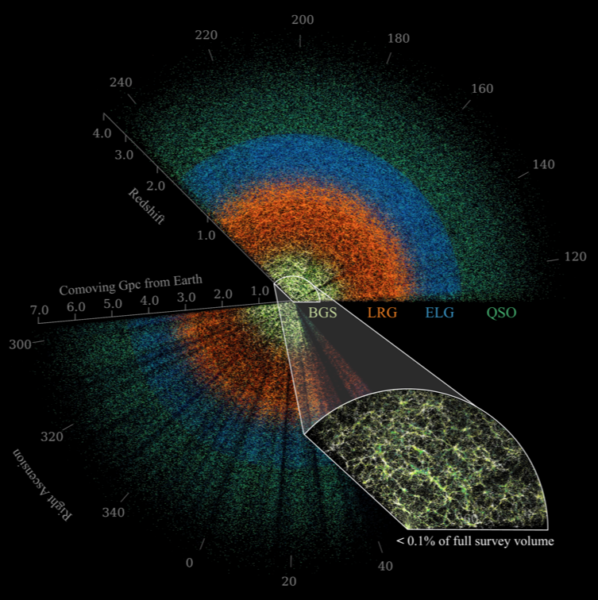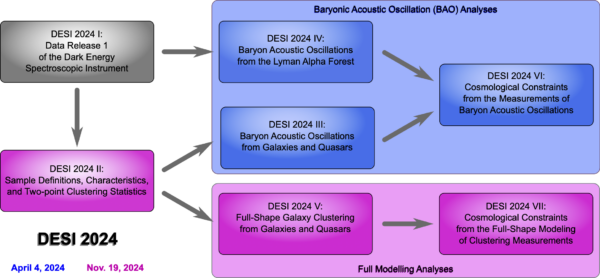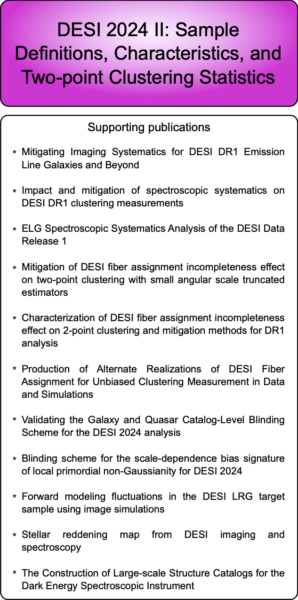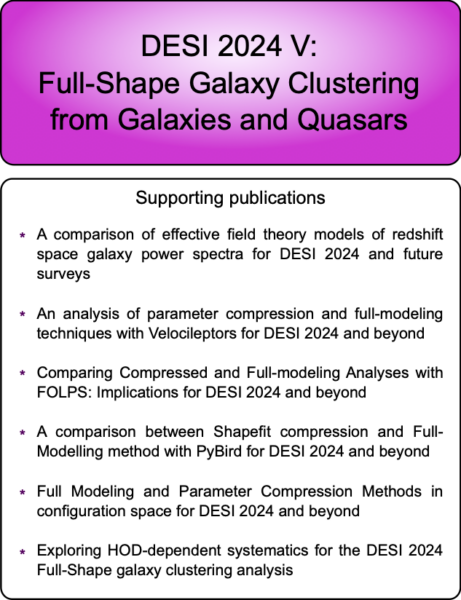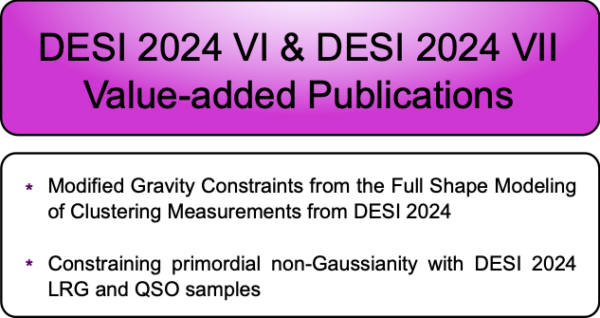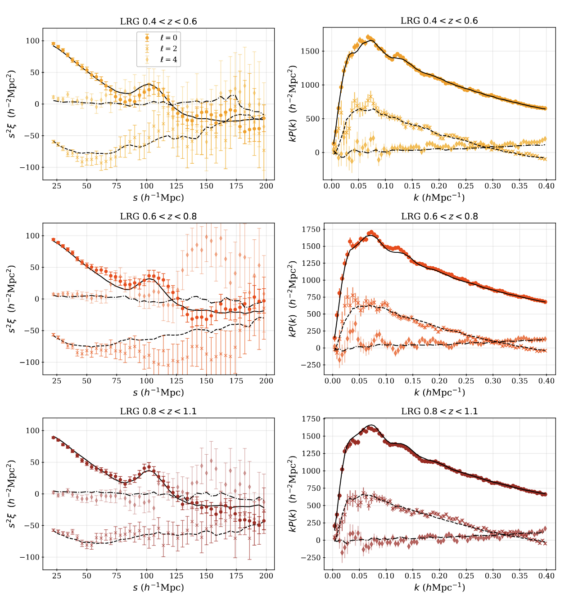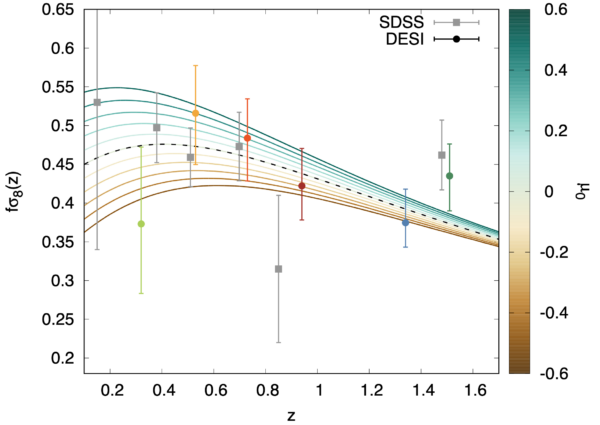On March 19, DESI released a set of papers providing the measurements and interpretation of Baryon Acoustic Oscillations (BAO) based on Data Release 2 (DR2) – the first three years of survey data. This page contains a guide to the publications and main results. The papers are available here and on arXiv.
In addition to these new results, Data Release 1 (DR1) is now publicly available, with its corresponding paper summarized at the end of this guide. For summaries of the papers based on DR1 results, see our 2024 paper guides from April 4 and November 19.
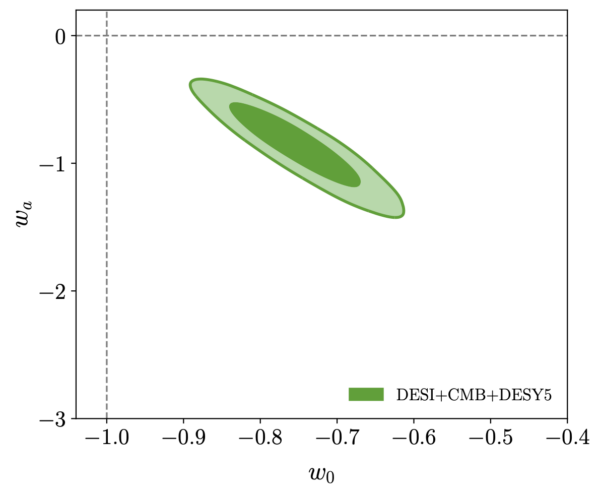
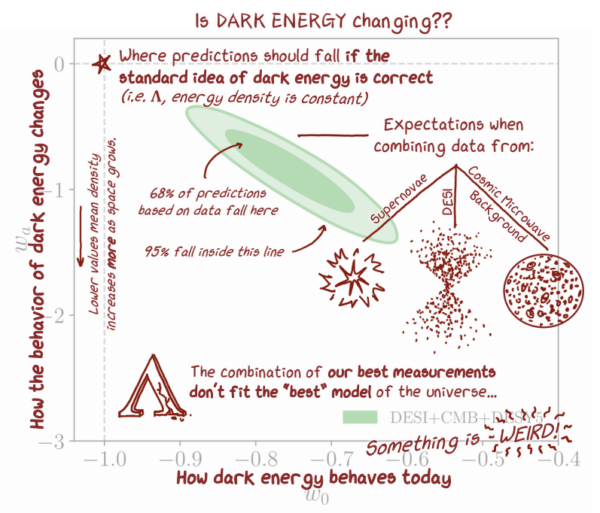
Helpful links
- A press release containing a high-level overview of our main results: https://newscenter.lbl.gov/2025/03/19/new-desi-results-strengthen-hints-that-dark-energy-may-evolve/
- A press release covering Data Release 1: https://newscenter.lbl.gov/2025/03/19/desi-opens-access-to-the-largest-3d-map-of-the-universe-yet/
- DESI’s YouTube channel, including a playlist of videos covering the DR2 BAO results: https://www.youtube.com/@DESISurvey
- A short video on our results for the general public: https://youtu.be/Td0jakzT-Lk
- A list of key publications from DESI: https://data.desi.lbl.gov/doc/papers/
- For more background on DESI’s science, see our public webpages.
- DESI’s public data releases, now including DR1: https://data.desi.lbl.gov/doc/releases/
The DR2 results fall into seven main analysis categories as shown in the first figure below. The two on the left-hand side highlighted in green focus on galaxy and quasar clustering, as well as clustering of the Lyman-alpha forest, and include the BAO results released on March 19. Also highlighted in green is cosmological inference, which is based on measurements from both the Lyman-alpha forest and galaxy and quasar clustering. The bottom figure lists the papers released on March 19, featuring two key papers along with five supporting papers.
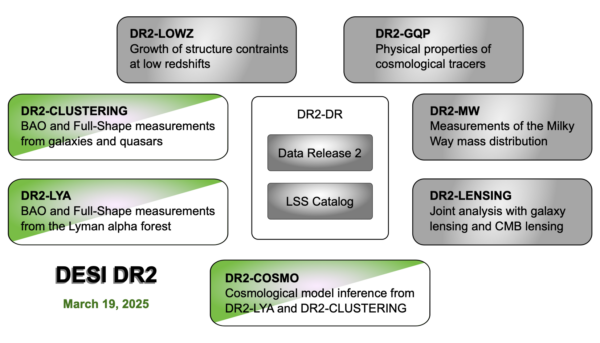
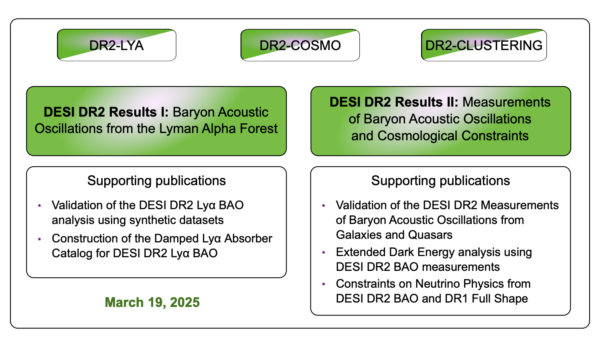
March 19 Paper Summaries
BAO Measurements from the Lyman-alpha Forest
Baryon Acoustic Oscillations (BAO) are a powerful standard ruler in cosmology, originating from ripples in the density of matter from the early universe. This ruler is used to constrain the universe’s expansion history by measuring the clustering of various tracers of the matter-density field. The most distant tracer used by DESI is the Lyman-alpha (Lyα) forest, a collection of absorption lines seen in the spectra of high-redshift quasars that map the distribution of neutral matter in the intergalactic medium. DESI’s DR2 results provide the most precise measurement of the BAO scale above redshift two.
DESI DR2 Results I: Baryon Acoustic Oscillations from the Lyman Alpha Forest
arXiv: 2503.14739
Summary: We have obtained the most precise measurement of the baryon acoustic oscillation scale above redshift two ever recorded, with a statistical precision of only 0.65 percent. The extremely high quality of this measurement when the universe was only about 3 billion years old is an important part of DESI’s new results on the history of cosmic expansion.
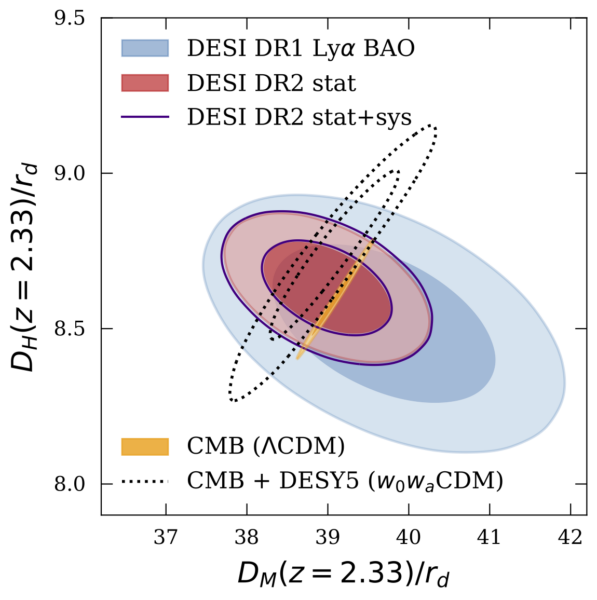
Validation of the DESI DR2 Lyα BAO analysis using synthetic datasets
Corresponding author: Laura Casas
arXiv: 2503.14741
Summary: The second data release (DR2) of the Dark Energy Spectroscopic Instrument (DESI), containing data from the first three years of observations, doubles the number of Lyman-α (Lyα) forest spectra in DR1 and it provides the largest dataset of its kind. To ensure a robust validation of the BAO analysis using Lyα forests, we have made significant updates to both the mocks and the analysis framework used in the validation, which we present in this paper. The figure presents the BAO measurement results from two sets of mocks: a stack of 100 Saclay mocks (previously used in DR1) and 300 CoLoRe-QL mocks (a new set of Gaussian Lyα mocks that incorporate a quasi-linear input power spectrum to model the non-linear broadening of the BAO peak). Our goal was to recover the true BAO parameters within one-third of the statistical uncertainty from DESI DR2 (represented by the black dotted line in the figure). The results indicate we are very close to meeting this criterion, and we discuss the small bias observed in Section 5 of the paper.

Construction of the Damped Lyα Absorber Catalog for DESI DR2 Lyα BAO
Corresponding author: Allyson Brodzeller
arXiv: 2503.14740
Summary: Damped Lyman-alpha absorption (DLA) systems are neutral hydrogen reservoirs with column densities N(HI)>2×1020 cm-2 observable in the Lyman-alpha forest of some quasars. The absorption profile of DLAs consist of broad damping wings that extend for thousands of km/s, compromising a significant fraction of the Lyman-alpha forest when present. It is therefore crucial to identify, catalog, and mask DLAs to mitigate their impact on Lyman-alpha forest clustering. This paper presents the DLA catalog strategy for the DR2 Lyα BAO measurement. The catalog is constructed using three DLA classification algorithms: the Gaussian process model from Ho et al. (2021), the CNN from Wang et al. (2022), and a spectral template DLA classifier which this work introduces. Our final DLA catalog for Lyman-alpha BAO is estimated to be 76% pure and 71% complete.
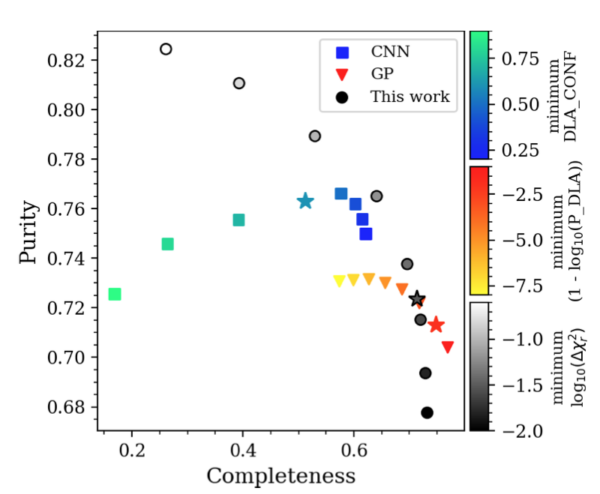
BAO Measurements from Galaxies and Quasars & Cosmological Constraints
The rest of DESI’s BAO results come from using galaxies and quasars as tracers of large-scale structure. Cosmological constraints are then derived from the combination of these measurements with those from the Lyman-alpha forest (described above). This dataset – more than twice the size of DR1 – is the largest ever used to measure BAO. These new results provide the best measurements of the BAO scale to date, enabling precise constraints on dark energy.
DESI DR2 Results II: Measurements of Baryon Acoustic Oscillations and Cosmological Constraints
arXiv: 2503.14738
Summary: This paper presents the measurement of baryon acoustic oscillations in six different galaxy and quasar samples from the first three years of DESI observations, and explores the implications of these results for cosmology when combined with the CMB, supernovae and weak lensing. The evidence for a time-evolving dark energy equation of state has increased since the Year 1 results, which is very exciting! We’ve also performed a lot of extra tests this time which make us confident that the result isn’t driven by some unknown effect in any of the data.
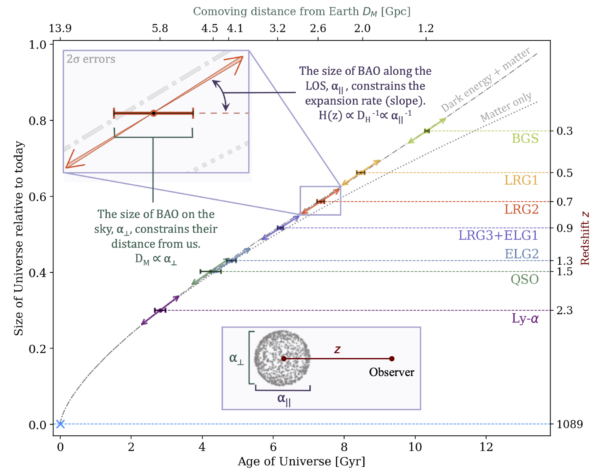
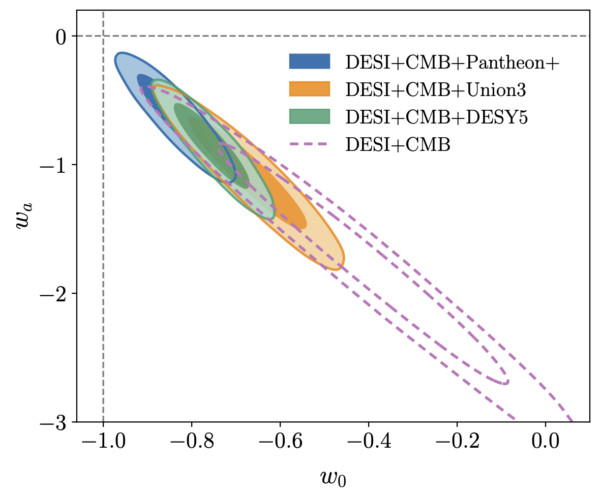
Validation of the DESI DR2 Measurements of Baryon Acoustic Oscillations from Galaxies and Quasars
Corresponding author: Uendert Andrade
arXiv: 2503.14742
Summary: The DESI DR2 BAO analysis significantly improves constraints on cosmic expansion by leveraging a larger dataset of galaxies and quasars compared to DR1. Our results confirm the robustness of BAO as a standard ruler and achieve a factor of ~2 improvement in precision, reducing statistical uncertainties to ~0.24%. A key plot (below) showcases the stability of BAO constraints across different data vectors and modeling choices, ensuring the reliability of our findings for cosmological inference.
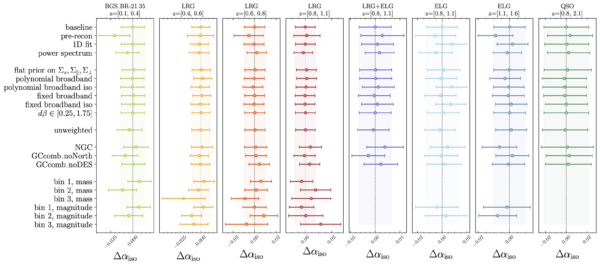
Extended Dark Energy analysis using DESI DR2 BAO measurements
Corresponding author: Kushal Lodha
arXiv: 2503.14743
Summary: In this paper, we perform an extensive analysis of dark energy using the latest DESI data, combined with CMB and SN Ia observations. Using a variety of parametric and non-parametric methods, our results indicate that extending the standard ΛCDM model with a two-parameter w(z) sufficiently captures trends in the current data. The evidence for dynamic dark energy, especially at low redshift (z<0.3), is robust across various methods.
The comparison of Gaussian Processes reconstruction of the dark energy equation of state w(z) with the w0wa parameterization using DESI, CMB, and Union3 data is shown in the figure below. See Figure 10 in the paper for more details.
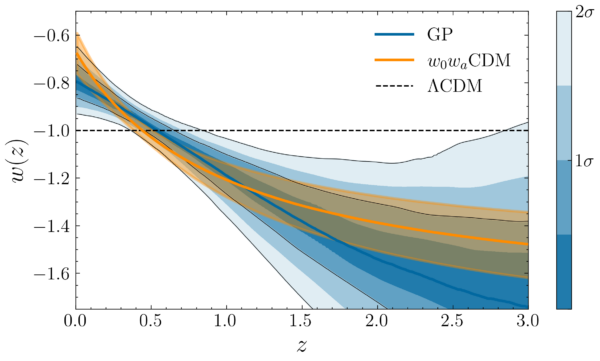
Constraints on Neutrino Physics from DESI DR2 BAO and DR1 Full Shape
Corresponding author: Willem Elbers
arXiv: 2503.14744
Summary: We have pushed measurements of the Universe’s most elusive particles—neutrinos—to new limits by analyzing the positions of millions of galaxies. The results indicate that the combined mass of all three neutrino types is less than 0.0642 electron volts—a value that creates tension with the lower limit of 0.059 eV established by laboratory experiments. Statistical methods surprisingly indicated physically impossible negative masses, pushing the tension to a significance of 3σ. When allowing for evolving dark energy, the tension disappeared with a revised upper limit of 0.163 eV—potentially signaling new physics beyond the standard cosmological model.
Data Release 1 (DR1)
In addition to the papers described above, DESI’s first year data release (DR1) is now publicly available. The corresponding paper below provides an in-depth overview of this release.
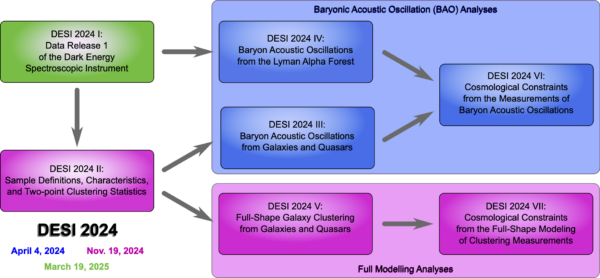
Data Release 1 of the Dark Energy Spectroscopic Instrument
arXiv: 2503.14745
Summary: This paper describes DESI public Data Release 1, covering the first year of DESI main survey observations and a consistent reprocessing of Survey Validation data previously released in the Early Data Release. DR1 includes high-quality redshifts for 18.7M objects, of which 13.1M are spectroscopically classified as galaxies, 1.6M are quasars, and 4M are stars.
